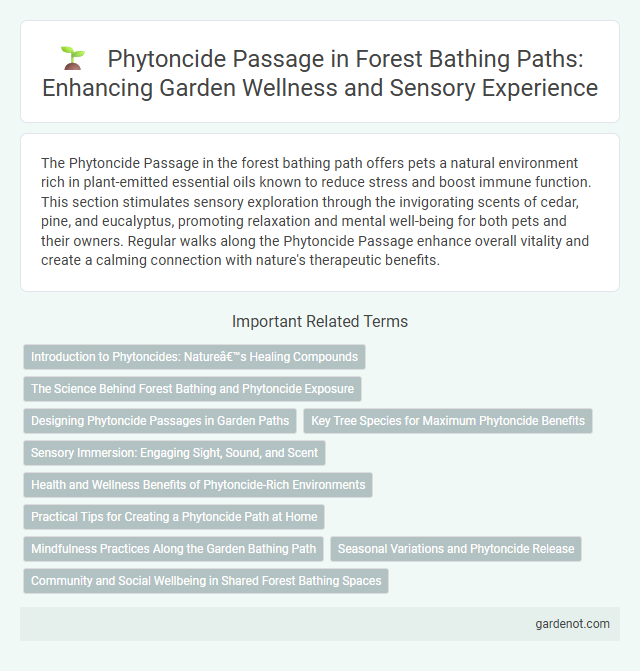The Phytoncide Passage in the forest bathing path offers pets a natural environment rich in plant-emitted essential oils known to reduce stress and boost immune function. This section stimulates sensory exploration through the invigorating scents of cedar, pine, and eucalyptus, promoting relaxation and mental well-being for both pets and their owners. Regular walks along the Phytoncide Passage enhance overall vitality and create a calming connection with nature's therapeutic benefits.
Introduction to Phytoncides: Nature’s Healing Compounds
Phytoncides are natural organic compounds emitted by trees and plants, known for their antimicrobial and anti-inflammatory properties that support human health. Exposure to these biogenic volatile substances during forest bathing enhances the immune system, reduces stress hormones, and promotes overall well-being. Scientific studies reveal that inhaling phytoncides increases the activity of natural killer cells, which play a crucial role in the body's defense mechanisms.
The Science Behind Forest Bathing and Phytoncide Exposure
Phytoncides are antimicrobial volatile organic compounds emitted by trees and plants, playing a crucial role in forest bathing by enhancing immune function and reducing stress hormones. Scientific studies reveal that exposure to phytoncides increases natural killer cell activity, which helps in combating infections and cancer. Regular immersion in forest environments rich in phytoncides supports mental well-being and physiological health through improved autonomic nervous system balance and lowered blood pressure.
Designing Phytoncide Passages in Garden Paths
Designing Phytoncide passages in garden paths involves integrating aromatic plants that emit natural antimicrobial compounds, enhancing both wellness and air quality. Selecting species like pine, cypress, and eucalyptus maximizes phytoncide concentration, promoting relaxation and immune support. Proper spacing and airflow optimize the dispersion of these beneficial volatile organic compounds along the path.
Key Tree Species for Maximum Phytoncide Benefits
Key tree species such as Japanese cedar (Cryptomeria japonica), hinoki cypress (Chamaecyparis obtusa), and pine (Pinus densiflora) release high levels of phytoncides, natural compounds known to enhance immune function and reduce stress. These trees emit volatile organic compounds that improve air quality and promote relaxation along the phytoncide passage. Selecting these species ensures maximum health benefits for visitors engaging in forest bathing experiences.
Sensory Immersion: Engaging Sight, Sound, and Scent
The Phytoncide Passage enhances sensory immersion by surrounding visitors with a blend of natural aromas emitted by trees, stimulating the sense of smell while promoting relaxation. Vibrant foliage and dappled sunlight engage the visual senses, creating a calming and restorative environment. The gentle rustling of leaves and distant bird calls further enrich the auditory experience, deepening the connection to nature.
Health and Wellness Benefits of Phytoncide-Rich Environments
Phytoncide passage in forest bathing paths significantly enhances health and wellness by releasing natural antimicrobial compounds that reduce stress hormones and boost the immune system. Exposure to phytoncide-rich environments lowers blood pressure, improves mood, and increases natural killer cell activity, which helps the body fight infections and cancer. Regular immersion in these aromatic woodland areas promotes mental clarity, reduces anxiety, and supports overall physical vitality through enhanced respiratory function and detoxification.
Practical Tips for Creating a Phytoncide Path at Home
Creating a phytoncide passage at home involves selecting native evergreen trees and shrubs such as cedar, cypress, and pine, which naturally emit antimicrobial essential oils. Incorporate a winding path with natural materials like wood chips or gravel to enhance immersion and promote relaxation through sensory engagement. Maintain regular pruning and watering to sustain healthy foliage and optimize the release of phytoncides, contributing to improved air quality and stress reduction.
Mindfulness Practices Along the Garden Bathing Path
Phytoncide passage enriches mindfulness practices along the forest bathing path by immersing visitors in the natural release of antimicrobial volatile organic compounds emitted by trees. Exposure to these phytoncides enhances mental clarity and reduces stress, promoting a deeper connection with nature. Integrating sensory awareness techniques in this environment cultivates present-moment focus and holistic well-being.
Seasonal Variations and Phytoncide Release
The Phytoncide passage experiences notable seasonal variations, with the highest concentrations of phytoncides released during the spring and early summer months when trees actively produce essential oils. Coniferous species like pine and cedar emit increased levels of these antimicrobial compounds, enhancing the forest's ability to cleanse the air and boost immune function. Autumn and winter see a decline in phytoncide release due to reduced metabolic activity in trees, making spring the optimal season for forest bathing to maximize health benefits.
Community and Social Wellbeing in Shared Forest Bathing Spaces
Phytoncide passages in forest bathing paths foster community and social wellbeing by creating shared spaces that encourage group mindfulness and connection with nature. Exposure to natural phytoncides released by trees supports stress reduction and immune health, enhancing collective psychological resilience. These communal environments promote social bonding, reduce feelings of isolation, and strengthen a sense of belonging among participants.
Phytoncide passage Infographic

 gardenot.com
gardenot.com